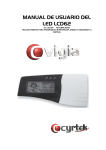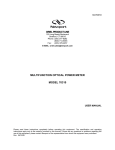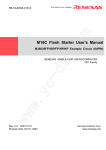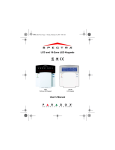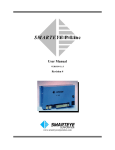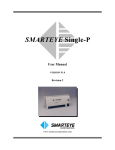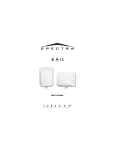Download VOICE GUIDE KEYPAD LED63VG
Transcript
18020502_A_en_LED63VG VOICE GUIDE KEYPAD LED63VG Disclaimer J2 J1 J0 • While every effort has been made to ensure that the information in this manual is accurate and complete, no liability can be accepted for any errors or omissions. • The manufacturer reserves the right to change the specifications of the equipment described in this manual without notice. Wire opening • Tamper This document contains information proprietary to the manufacturer. No part of this publication may be reproduced, photocopied, stored on a retrieval system or transmitted, without prior written permission of the manufacturer. GREEN YELLOW RED BLACK GND JT INPUT Figure 2. Back Cover Voice Guide Keypad - LED63VG User Manual 2 3 23 Voice Guide Keypad - LED63VG User Manual Real time clock adjustment key sequence: CODE 7 CORRECTION PRG 9 (2 beeps) ENT Jumper Settings Address 0 1 2 3 4 5 6 7 J0 0 0 0 0 1 1 1 1 J1 0 0 1 1 0 0 1 1 J2 0 1 0 1 0 1 0 1 JT 1 0 0 0 0 0 0 0 Contents Disclaimer General Information Limited Warranty Warnings Overview Sound Indication Voice Messages LED Indication Keypad Operation Arming Full Stay Force Instant Panic Disarming Stopping the Alarm Ambush Code Voice Guide Keypad - LED63VG User Manual 22 3 2 4 4 4 5 5 5 7 7 8 8 8 8 9 9 10 10 11 11 User Level Programming 11 User Code Change Bypassing Technical Troubles Review Events Memory Review Chime Enable/Disable 12 12 12 13 15 Manager Level Programming Manager Code Change Changing User Code/Rights Events Memory Review Chime Enable/Disable Bypassing Setting the Clock Setting the Date Adding a Proximity Card Removing a Proximity Card Real Time Clock Adjustment Jumper Settings 16 16 17 19 19 20 20 20 21 21 21 22 Voice Guide Keypad - LED63VG User Manual General Information Limited Warranty The manufacturer warrants that for period of 12 months from the date of purchase, the product shall be free of defects in material and workmanship under normal use and that in fulfillment of any breach of such warranty, the manufacturer shall, at his discretion, repair or replace the defective equipment upon returning it to its factory. This warranty shall apply to defects in parts and workmanship only and not to damages incurred during shipping or handling, nor due to causes beyond the control of the manufacturer such as lightning, excessive voltage, mechanical shock, or damages arising from abuses, unauthorized alternations or misuse of the equipment. The warranty shall apply to the original buyer only, and is and shall be in lieu of any and all other warranties, whether expressed or implied and of all other obligations or liabilities on the part of the manufacturer. This warranty contains the entire warranty. The manufacturer shall neither assume, nor authorizes any other warranty or liability concerning this product. In no event shall the manufacturer be liable for any direct or indirect or consequential damage, loss of anticipated profits, loss of time or any other losses incurred by the buyer in connection with the purchase, installation or operation or failure of this product. The manufacturer recommends that the entire system be completely tested on a regular basis. However, despite frequent testing, and due to, but not limited to, criminal tampering or electrical disruption, it is possible for this product to fail to perform as expected. Warnings Before using the LED63VG Keypad, please make sure that you have read and understood the following instructions. Always make sure that the LED63VG Keypad is operated correctly. Do not attempt to disassemble or alter any part of the equipment that is not expressly described in this guide. Internal inspections, alterations and repairs should be conducted by qualified service personnel only. Do not use substances containing alcohol, benzene, thinners or other flammable substances to clean or maintain the equipment. The use Voice Guide Keypad - LED63VG User Manual 4 Adding a Proximity Card Real Time Clock Adjustment To use proximity cards the system has to be equipped with a proximity card reader. Key sequence for adding a proximity card: Arbitrary units are used for real time clock adjustment. One unit corresponds to every 5 seconds deflection per month. The value of 50 means there is no need for adjustment. The following method is used to calculate the necessary adjustment. The necessary adjustment is calculated by determining the number of days taken for the clock to deflect by 1 minute. The adjustment value is found by dividing the number 360 by the number of days found in the previous step. The result obtained is added to the current value in the case of a slow clock or is subtracted from the current value in case the clock runs fast. The figure thus obtained is entered into the system. Example: Let us suppose the clock is running slow by 1 minute in 85 days. The figure 4.2 is obtained when 360 is divided by 85. The adjustment value of 54 is obtained when the figure 4 is added to the current set figure of 50. CODE 6 PRG (2 0 USER ID (00-16) beeps) ENT The card must be positioned near the card reader. Removing a Proximity Card The key sequence for removing a proximity card: CODE 6 PRG (2 1 USER ID 21 (00-16) beeps) ENT Voice Guide Keypad - LED63VG User Manual Bypassing Setting the Clock To execute a bypass operation the manager is required to enter his personal code: To set the clock the manager is required to enter his personal code. The set entries are visualized in binary-hexadecimal form. Key sequence for setting the clock: CODE PRG 4 0 CODE Pressing a numeric key bypasses the respective zone. The display LED, corresponding to the zone number, lights up permanently. Pressing the same key once again de-bypasses the zone and the LED goes out. The selected programming is confirmed by pressing the ENT key. Bypassing sequence (e.g. zone 2): 2 2 (2 beeps) 0 NEW TIME (HHMM) ENT Setting the Date To set the date the manager is required to enter his personal code. The set entries are visualized in binary-hexadecimal form. Key sequence for setting the date: CODE 2 5 PRG 1 NEW DATE 5 PRG (2 beeps) (DDMM) ENT of these substances may lead to fire. No liquids should enter the interior. Overview The LED63VG Keypad is designed to control the CA60Plus Control Panel and provides the user with system status information. The Control Panel is fully programmable with the LED63VG keypad. An LED indication on the keypad visualizes the system status and alarm events information. A sound buzzer informs the user about correct or incorrect key entries as well as activated alerts. Seven voice messages provide the user with addition information. Sound Indication There are seven different sound combinations that indicate seven different conditions: • Click – single short beep indicating the pressing of a key; • Confirm – two long sound signals, indicating the system confirmation to a successfully executed operation; • Reject – a single long beep, indicating an incorrectly executed operation; • Entry time – continuous beep, indicating intrusion into an entrance zone; • Exit time – short beeps, indicating the system is armed and the user is required to leave the entrance zone. Ten seconds before the exit time is over beep frequency increases; • Technical problem – two short beeps, indicating a technical problem; • Chime – short beeps with subsequently increasing frequency, indicating intrusion into a zone with an activated chime option; Voice Messages There are seven different voice messages that indicate different conditions: • “System is armed” • “System is disarmed” • “Please enter your code to disarm” • “AC power is lost” • “Battery is discharged” • “Please leave the premises” • “Alarm in the system” ENT Voice Guide Keypad - LED63VG User Manual 20 5 Voice Guide Keypad - LED63VG User Manual NOTE: Forbidding all user permissions will automatically erase the programmed code combination. Events Memory Review Zone LED Indicators To review event memory the manager is required to enter a valid personal code. Microspeaker CODE Keypad Press To enable or disable chime mode the manager is required to enter a valid code. Chime enable/disable key sequence: CODE MEM for a following one. Press the ENT PRG 3 0 to for a previous event and LED Indicators Chime Enable/Disable key to see more Pressing any numeric key alternatingly switches state of chime on and off. The preferred state is confirmed by pressing the ENT key. information on a zone number or a user code. Information on the events, as well as the zone numbers and the users is presented in binary-hexadecimal form. Use the table on pages 14 and 15 to interpret them. Keypad Cover (open) ENT Figure 1. Frontal view of the keypad with the cover opened Voice Guide Keypad - LED63VG User Manual 6 19 Voice Guide Keypad - LED63VG User Manual Now the manager can switch over between code change mode and user permissions mode, using the and LED Indication keys. Originally the system is in code change mode. LEDs 3, 4, 5 and 6 light up to indicate the number of code digits left to be entered. Bypass Disarm Full arm Stay arm Review event memory Force arm Pressing a numeric key alternatingly switches over the state of the respective operation from forbidden to permitted. Selection is confirmed by pressing The manager is expected to enter the new user code. Entering new user code key sequence: NEW CODE beeps) (4 digits) NEW CODE the ENT key. User permissions key sequence: 3 LED Light Blinking RDY (green) System ready Programming mode ARM (red) System armed Exit time / Programming mode TRBL (red) - Technical problem / Programming mode BPS (red) Bypassed zones - TAMP (red) Tamper memory Tamper MEM (red) Alarm memory Activated fire detector 1 - 6 (red) Alarm memory Activated zone detector Keypad ARM arms the system (See page 8) DISARM disarms the system (See page 10) BPS bypasses certain zone(s) (See pages 12, 20) TRBL reviews system troubles (See page 12) MEM reviews event memory (See page 13) (2 PRG CLR (reenter) The new code is accepted and the system automatically enters user permissions mode. The LEDs indicate the respective operations the user is allowed to execute. The lit numbers indicate the permitted programs. 3 Voice Guide Keypad - LED63VG User Manual 3 ENT 18 7 ENT activates programming mode (See pages 11, 16) clears entered data or transfers to previous menu level confirms entered data or transfers to next menu level scroll event memory (See pages 13, 19) Voice Guide Keypad - LED63VG User Manual Operation Stay Arming The system can be armed only if the green RDY1 LED is lit up. Full Full arming means all zones are secured. Anyone coming into the entrance zone is required to enter a code. Otherwise the alarm is triggered after entrance time is over. Full arming sequence: CODE ARM Quick full quence: ARM arming 0 CODE se- The new code has been accepted and the system automatically enters remote access permissions mode. The LEDs stand for the remote access allowable operations. The lit numbers indicate the permitted programs. 3 3 1 ARM Remote access permissions key sequence: 3 Quick stay arming key sequence: ARM 0 key Stay arming means the user is allowed to stay in (a) certain zone(s), but the entrance zone is secured. Anyone coming into the entrance zone is required to enter a code. Otherwise the alarm is set off after the entrance time is over. Stay arming key sequence: Remote disarm 1 Remote arm The BPS LED lights up permanently on the display and the LEDs, corresponding to the numbers of the zones which are not armed, blink slowly. The ARM1 LED lights up. Remote code access Remote bypass Remote event memory review Remote programming Pressing a numeric key alternatingly switches over the state of the respective remote operation from forbidden to permitted. Pressing the the selection. ENT key confirms ENT Changing User Code and Rights To change the user code, the manager is required to enter his personal code first before the user code. User code change key sequence: CODE PRG USER (01-16) ID (2 beeps) Voice Guide Keypad - LED63VG User Manual 8 17 Voice Guide Keypad - LED63VG User Manual Manager Level Programming As a rule of thumb you can enter user programming mode using the following procedure: Step 1: Enter valid user code Manager Code Change Force Instant The manager is required to enter his current personal code before changing it. Manager code change key sequence: Force arming means the system is armed although in (a) certain zone(s) there may be obstacles or troubles. Forced arming key sequence: CODE CODE Instant arming means the user is allowed to stay in certain zone(s), but the entrance zone is secured. The difference with the stay arming is that intrusion into the entrance zone immediately sets on the alarm. Instant stay arming key sequence: PRG once Step 3: Enter a parameter number (two digits - see address table) Step 4: Change parameter value Step 5: Press and CLR ENT The manager can switch between code change mode and remote access permissions mode with the and keys. to confirm to reject changes. A blinking RDY1 LED indicates that the system is in programming mode. The system is originally in change code mode. LEDs 3, 4, 5 and 6 light up to indicate the number of code digits left to be entered. The manager is expected to enter the new code. Key sequence for entering new manager code: NEW CODE beeps) Voice Guide Keypad - LED63VG User Manual (4 digits) NEW CODE ARM 2 Quick forced arming key sequence: (2 beeps) 0 Step 2: Press 0 PRG CODE 2 ARM The BPS LED lights up and the LED’s corresponding to the numbers of the zones which are not armed, blink slowly. ARM 3 Quick instant stay arming key sequence: ARM 3 The BPS LED lights up and the LEDs, corresponding to the numbers of the zones, which are not armed, blink slowly. (2 (reenter) 16 9 Voice Guide Keypad - LED63VG User Manual NOTE: With all arming modes, except Instant, after exit time starts running, the “Please leave the premises” voice message will sound every 5 seconds. The buzzer will indicate that exit time is running. Ten seconds before exit time is over, beep frequency will increase. After arming, the “System is armed” message will be repeated twice. After each of the procedures described above, except Instant, a blinking RDY1 LED also indicates that exit time is running and that the user is to leave the armed zones. In the events of AC loss and low battery, the “AC power is lost” or “Battery discharged” messages will sound correspondingly 3 times every 5 seconds when arming is attempted. Panic Pressing and holding CLR + ENT sends an alarm signal to the station without triggering the siren. Disarming If a person comes into the entrance zone, the voice message “System is armed. Please enter your code to disarm.” will sound every 5 seconds. The buzzer will indicate that entry time is running. The user is required to enter a personal code: CODE After a valid code has been entered, the message “System disarmed” will be repeated twice. If no valid code has been entered during entry time, the “System is armed” message will sound. If an alarm has been triggered in the system, the message “Alarm in the system. Please enter your code to disarm” will be repeated every 5 seconds. NOTE: Certain users may not be allowed to disarm the system. In the events of AC loss and low battery, the “AC power is lost” or “Battery discharged” messages will sound correspondingly 3 times every 5 seconds when disarming is attempted. Event Description Code 1 2 3 4 5 6 Duress code entry 30 1 2 3 4 5 6 User Telephone line failure 31 1 2 3 4 5 6 0 Telephone line recovery 32 1 2 3 4 5 6 0 Communication error 33 1 2 3 4 5 6 0 Automatic test 34 1 2 3 4 5 6 0 Manual test 35 1 2 3 4 5 6 0 Fuse blown 36 1 2 3 4 5 6 0 Fuse recovery 37 1 2 3 4 5 6 0 System reset 38 1 2 3 4 5 6 0 Power supply failure 39 1 2 3 4 5 6 0 Power supply recovery 40 1 2 3 4 5 6 0 Battery low or missing 41 1 2 3 4 5 6 0 Battery recovery 42 1 2 3 4 5 6 0 Chime Enable/Disable To enable or disable chime mode the user is required to enter a valid code. Chime enable/disable key sequence: CODE 10 3 PRG Pressing any numeric key alternatingly switches state of chime on and off. The preferred state is confirmed by pressing the Voice Guide Keypad - LED63VG User Manual Zone/User 15 ENT ENT key. Voice Guide Keypad - LED63VG User Manual Event Description Code 1 2 3 4 5 6 Zone/User Alarm activated 1 1 2 3 Alarm deactivated 2 1 2 3 4 5 6 Zone number 4 5 6 Fire alarm activated 3 1 2 Zone number 3 4 5 6 Zone number Fire alarm deactivated 4 1 2 3 4 5 6 Zone number Panic alarm activated 5 Panic alarm deactivated 6 1 2 3 4 5 6 Zone number 1 2 3 4 5 6 Zone number Tamper alarm activated 7 1 2 Tamper alarm deactivated 8 1 2 3 4 5 6 Zone number 3 4 5 6 Zone number Medical alarm activated 9 1 2 3 4 5 6 Zone number Medical alarm deactivated 10 1 Zone bypassed 11 1 2 3 4 5 6 Zone number 2 3 4 5 6 Zone number Zone de-bypassed 12 Fire zone bypassed 13 1 2 3 4 5 6 Zone number 1 2 3 4 5 6 Zone number Fire zone de-bypassed Panic zone bypassed 14 1 2 3 4 5 6 Zone number 15 1 2 3 4 5 6 Zone number Panic zone de-bypassed 16 1 2 3 4 5 6 Zone number Tamper zone bypassed 17 1 2 3 4 5 6 Zone number Tamper zone de-bypassed 18 1 2 3 4 5 6 Zone number Medical zone bypassed 19 1 2 3 4 5 6 Zone number Medical zone de-bypassed 20 1 2 3 4 5 6 Zone number Disarming 21 1 2 3 4 5 6 User Remote disarming 22 1 2 3 4 5 6 User Zone number Disarming by switch 23 1 2 3 4 5 6 Arming 24 1 2 3 4 5 6 User Remote arming 25 1 2 3 4 5 6 User Arming by switch 26 1 2 3 4 5 6 Zone number Quick arming 27 1 2 3 4 5 6 None Engineer menu entry 28 1 2 3 4 5 6 17 Engineer menu exit 29 1 2 3 4 5 6 17 Voice Guide Keypad - LED63VG User Manual 14 Stopping the Alarm The alarm is stopped by entering a personal code: CODE After a valid code has been entered, the message “System disarmed” will be repeated twice. NOTE: In the events of AC loss and low battery, the “AC power is lost” or “Battery discharged” messages will sound correspondingly 3 times every 5 seconds. After a code has been entered, the “System disarmed” message will be repeated twice. User Level Programming As a rule of thumb you can enter user programming mode using the following procedure: Step 1: Enter a valid user code Ambush Code Step 2: Press Ambush code is a personal code that disarms the system, but still sends an alarm signal. Its purpose to indicate that the user is forced to disarm the system against his/ her will. The ambush code is calculated from the personal code by adding 1 to the last digit. If the last number is 9, it is replaced by 0 in the ambush code. Step 3: Enter a parameter number (one digit - see address table) Step 4: Change parameter value Example: Personal code: 4615 code: 4616 Personal code: 4619 code: 4610 11 Step 5: Press and CLR PRG ENT once to confirm to reject changes. A blinking RDY1 LED indicates that the system is in programming mode. Ambush Ambush Voice Guide Keypad - LED63VG User Manual User Code Change The user is required to enter his/ her current personal code before changing it. User code change key sequence: CODE PRG NEW CODE (4 digits) beeps) Bypassing key sequence (zone 2 used in the example): 2 0 2 2 (2 Battery low or missing Communication error Fuse blown NEW CODE (reenter) Bypassing To execute a bypass operation the user is required to enter a valid code: ENT BPS . Pressing a numeric key bypasses the respective zone. The LED, corresponding to the zone number, lights up. Pressing the same key once again de-bypasses the zone and the LED goes out. The selected programming is confirmed by pressing ENT . Technical Troubles Review To review troubles the user is required to enter a valid personal code: CODE To review event memory the user is required to enter a valid personal code. CODE MEM NOTE: Certain users may not be allowed to review event memory. TRBL In the events of AC loss and low battery, the “AC power is lost” or “Battery discharged” messages will sound correspondingly 3 times every 5 seconds. Each digit on the display indicates a specific technical problem. Voice Guide Keypad - LED63VG User Manual Phone line error Events Memory Review ENT CODE Tamper AC lost 12 Press to for a previous event and for a following one. Press the ENT Information on the events, as well as the zone numbers and the users is presented in binary-hexadecimal form. Use the table above to interpret them. For convenience the table also includes a graphic representation of the LEDs as they light up for the respective event. A black digit on white background indicates an extinguished LED, and a white digit on dark background indicates a lit up LED. Scroll from LED 1 to LED 6 to determine the correspondence between the event displayed on the keypad and the text in the table. The first 17 rows in the table are used for coding the user number and the zones. Example: Suppose that the event displayed on the keypad is represented by a LED combination of 2, 3, 5 and 6. The table discloses the first LED 2 data entry. The next data entries disclose that of the first LED 3. Next comes the first data entry of LED 5 and finally comes the first data entry of LED 6.This is the data entry with the ordinal number of 27 “Quick arming”. key to see more information on a zone number or a user code. 13 Voice Guide Keypad - LED63VG User Manual












